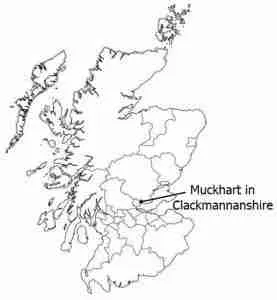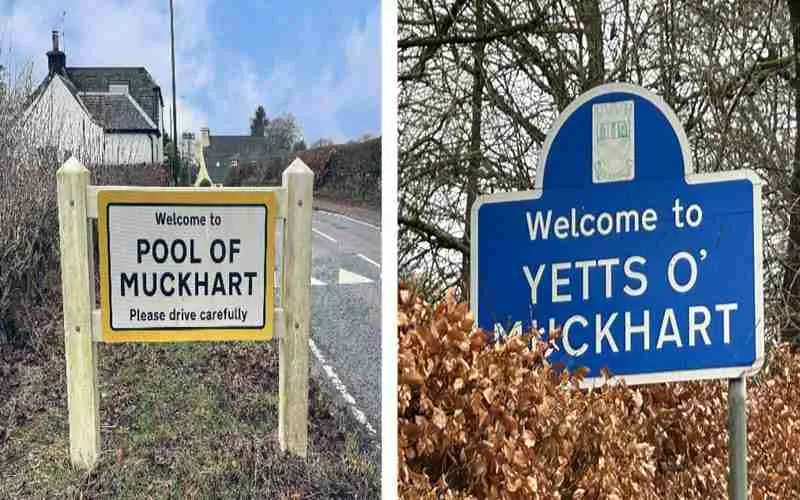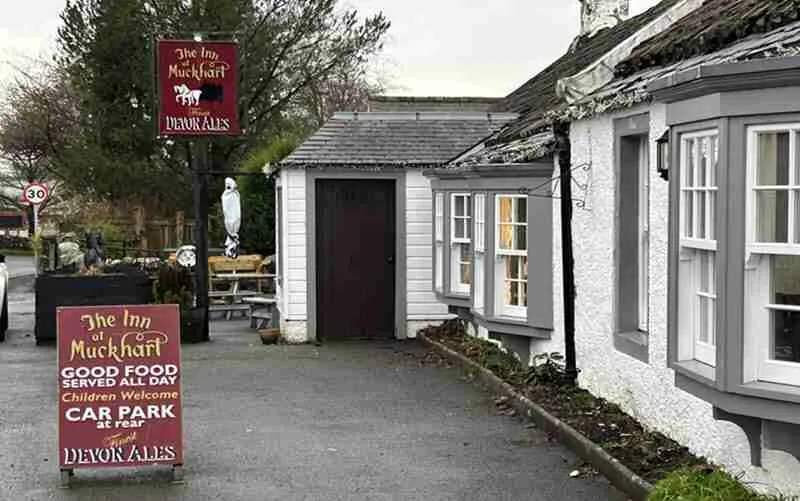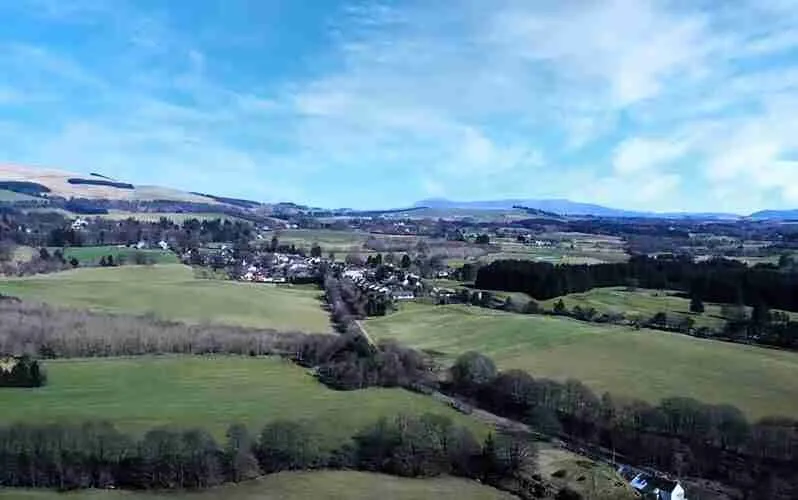
Join me as I explore the parish of Muckhart in Scotland. Nestled beside the Ochil Hills in the heart of Scotland, this little parish has a lovely history. Did your ancestor come from this parish?
Where is the parish of Muckhart in Scotland?
The parish of Muckhart once belonged in Perthshire before the reorganisation of council areas in 1971. Today, it is located in Clackmannanshire, a small council area between Stirlingshire and Perthshire.
The parish has two small villages: Pool of Muckhart and Yetts o’ Muckhart.
The Pool o’ Muckhart was once named after a small body of water situated to the south of the village. Despite the complete drainage of the pool, the name still remains.
Yetts o’ Muckhart is about quarter mile east of Pool o’ Muckhart. The term ‘Yetts’ is Scot for ‘gate’. In fact, the term referred to a 19th century tollhouse, or gatehouse, when 2 roads were created in 1810 and 1816. The roads were used for cattle drovers and stagecoaches travelling through the parish. The parish is strategically located beside the Ochil Hills where there was an established route for highland livestock to travel to lowland markets.
Origin and meaning of Muckhart
The parish was historically known as Mucard and the name evolved into Muckart and more recently into Muckhart. Its origins stem from Gaelic roots. ‘Muc‘ means a wild boar or pig, and ‘gart‘ or ‘ard‘ refers to high ground.
I have come across a couple of theories for this parish name:
- perhaps the parish was once infested by wild boar?
- others suggest that if you tilt your head in a certain way towards a hill behind the Yetts o’ Muckhart, then you might see the shape of a boar’s head!
The history of this small parish
During the 18th century, the parish was used as a stopover for drovers. They could refresh and rest their livestock en-route to markets in Clackmannanshire, Stirling, Perthshire, and Fife.
Apparently there were 13 public houses according to the 1845 Scottish Statistical Accounts. Only one remains today, the Inn of Muckhart.
However, the introduction of the railways in the mid-1800s, forced droving practices to diminish, prompting new developments in the parish. These developments focused on improving agriculture by the 3 main estates: Balliliesk, Cowden and Blairhill.
The estates provided a range of jobs for tenant farmers (including the Paterson family at Hillhead farm in Yetts o’ Muckhart), gardeners, labourers, grooms, gamekeepers, cooks, farm servants and many more. In particular, Cowden estate became home to Ella Christie in the early 1900s. She created a Japanese Garden which is open to the public. It is a lovely place and I highly recommend a visit if you are ever in the area. The last Japanese gardener, Matsuo, came to Cowden in 1925 and died in 1937. He is buried in the Muckhart cemetery.
In the 1860s,
there was a resident policeman who lived at Doune Cottage which had 2 prison cells attached to it. During this period, the policeman was expected to exercise greater empathy towards offenders. Actually, he was provided with a wheel barrel to wheel drunkards back to their homes.
In the early 1900s,
a Mr Robertson from Dunfermline moved to the parish and opened up a small shop. Apparently he used to sell one ounce of tobacco for 3 1/2 pence and a pipe was thrown in for good measure.
Nearby, the Blyth sisters who lived at Blyth Cottage sold vegetables and strawberries grown from their garden. This garden later became the bowling green. Since its closure, it is now the entrance to a new housing estate.
Muckhart Parish Church
Local historians suggest that there has been a church building on the current site since the 16th century. What happened to this building is unknown. However, it seems that a parish church was built in 1620, burned down by Montrose in 1645, rebuilt or restored in 1699, repaired again in 1715 and 1789.
The existing church was built in 1838.
The Muckhart cemetery has some really interesting old and new gravestones. For example, there are a couple of 18th century ‘table top’ tombs and a box tomb.
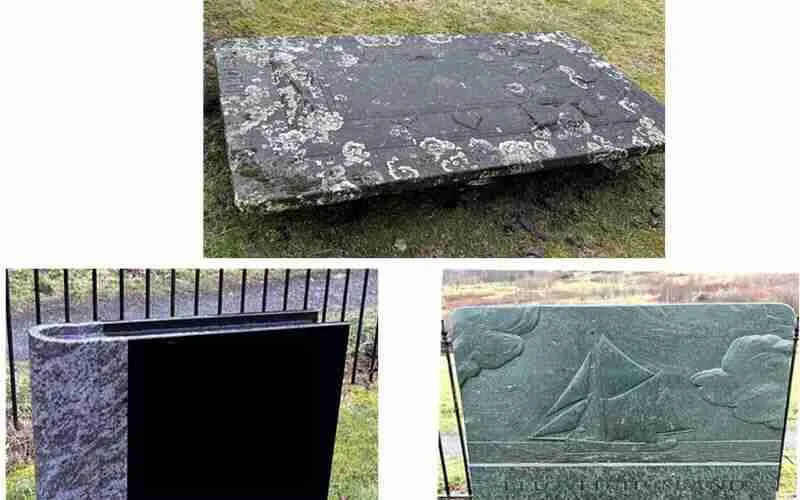
Tracing your Muckhart ancestors
If you fancy doing your own research, then you can trace your Muckhart ancestors in:
- birth, marriage and death registers at ScotlandsPeople.
- Muckhart Kirk Session minutes. My blog on Kirk Session minutes will explain how they can be useful with your research.
- tax records from ScotlandsPlaces.
- deeds documents from the National Records of Scotland.
- sasines, otherwise known as property documents.
- valuation rolls. These documents were property documents for taxation purposes and can identify proprietors and tenants.
Alternatively, get in touch with me and let’s see if I can help you with your research.
Thank you for joining me on this historical journey about Muckhart parish based in central Scotland. I hope you enjoyed reading my post as much as I like bringing these stories to light.
Let me know in the comments below if you want me to write about a particular parish in Scotland.
Good luck with your research.
Until my next post, haste ye back.
You may also like...
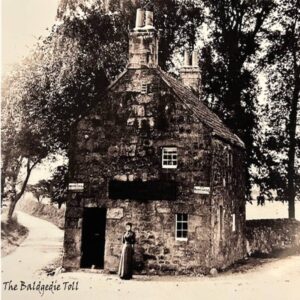
The Life of a Tollkeeper
A tollkeeper was a person who collected road fees from travellers. This old occupation was prominent during the 18th and 19th centuries.
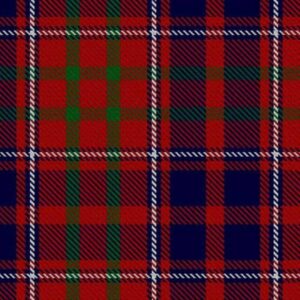
Cameron Surname: Origin, Meaning & History
The Cameron surname has Gaelic origins and it is associated with Clan Cameron, one of the most influential Highland clans.
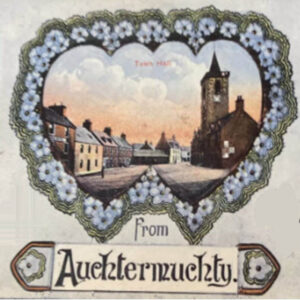
Ancestral Visit to Auchtermuchty, Fife
Auchtermuchty in Fife is known as Muchty to locals. What does Stratheden Whisky, Jimmy Shand and the Proclaimers have in common?
